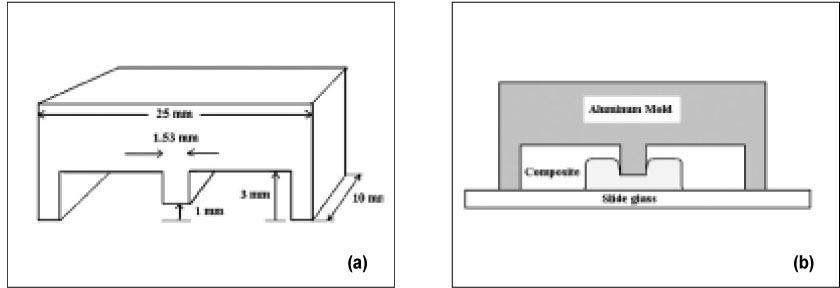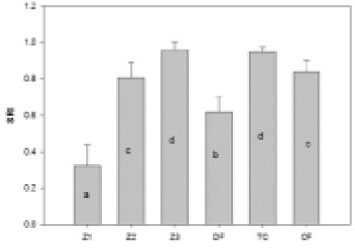Articles
- Page Path
- HOME > Restor Dent Endod > Volume 33(3); 2008 > Article
- Original Article Slumping resistance and viscoelasticity of resin composite pastes
- Hee Yeon Suh, In Bog Lee
-
2008;33(3):-245.
DOI: https://doi.org/10.5395/JKACD.2008.33.3.235
Published online: May 31, 2008
Department of Conservative Dentistry, School of Dentistry, Seoul National University, Korea.
- Corresponding Author: In Bog Lee. Department of Conservative Dentistry, School of Dentistry, Seoul National University, 275-1 Yeongeon-Dong, Jongno-Gu, Seoul 110-768, Korea. Tel: 82-2-2072-3953, Fax: 82-2-2072-3859, inboglee@snu.ac.kr
• Received: April 3, 2008 • Revised: April 26, 2008 • Accepted: April 29, 2008
Copyright © 2008 The Korean Academy of Conservative Dentistry
- 921 Views
- 1 Download
- 1 Crossref
Abstract
-
The aim of this study was to develop a method for measuring the slumping resistance of resin composites and to relate it to the rheological characteristics.Five commercial hybrid composites (Z100, Z250, DenFil, Tetric Ceram, ClearFil) and a nanofill composite (Z350) were used to make disc-shaped specimens of 2 mm thickness. An aluminum mold with square shaped cutting surface was pressed onto the composite discs to make standardized imprints. The imprints were light-cured either immediately (non-slumped) or after waiting for 3 minutes at 25℃ (slumped). White stone replicas were made and then scanned for topography using a laser 3-D profilometer. Slumping resistance index (SRI) was defined as the ratio of the groove depth of the slumped specimen to that of the non-slumped specimen. The pre-cure viscoelasticity of each composite was evaluated by an oscillatory shear test and normal stress was measured by a squeeze test using a rheometer. Flow test was also performed using a flow tester. Correlation analysis was performed to investigate the relationship between the viscoelastic properties and the SRI.SRI varied between the six materials (Z100 < DenFil < Z250 < ClearFil < Tetric Ceram < Z350). The SRI was strongly correlated with the viscous (loss) shear modulus G' but not with the loss tangent. Also, slumping resistance was more closely related to the resistance to shear flow than to the normal stress.Slumping tendency could be quantified using the imprint method and SRI. The index may be applicable to evaluate the clinical handling characteristics of composites.
- 1. Al-Sharaa KA, Watts DC. Stickiness prior to setting of some light cured resin composites. Dent Mater. 2003;19: 182-187.ArticlePubMed
- 2. Lee IB, Son HH, Um CM. Rheological properties of flowable, conventional hybrid, and condensable composite resins. Dent Mater. 2003;19: 298-307.PubMed
- 3. Craig RG, Powers JM. Restorative dental materials. 2002;11th Ed. Mosby Co.; 91-98. 231-251.
- 4. Bayne SC, Thompson JY, Swift EJ, Stamatiades P, Wilkerson M. A characterization of first-generation flowable composites. J Am Dent Assoc. 1998;129: 567-577.ArticlePubMed
- 5. Leinfelder KF, Bayne SC, Swift EJ. Packable composites: overview and technical considerations. J Esthet Dent. 1999;11: 234-249.ArticlePubMed
- 6. Opdam NJM, Roeters JJM, Peters TCRB, Burgersdijk RCW, Kuijs RH. Consistency of resin composites for posterior use. Dent Mater. 1996;12: 350-354.ArticlePubMed
- 7. Lee IB, Cho BH, Son HH, Um CM. The effect of consistency, specimen geometry and adhesion on the linear polymerization shrinkage measurement of light cured composites. Dent Mater. 2006;22: 1071-1079.PubMed
- 8. Tyas MJ, Jones DW, Rizkalla AS. The evaluation of resin composite consistency. Dent Mater. 1998;14: 424-428.ArticlePubMed
- 9. Barnes HA, Hutton JF, Walters K. An introduction to rheology. 1989;1st edi. Elsevier Science Publishing Co; 64-73.
- 10. Rheology and its application. 2001;1st edi. The Korean society of rheology; 3-103. 175-191.
- 11. Summitt JB, Robbins JW, Hilton TJ, Schwartz RS. Fundamentals of operative dentistry: A contemporary approach. 2006;3rd Ed. Quintessence books; 319-323.
- 12. Jackson RD, Morgam M. The new posterior resins and a simplified placement technique. JADA. 2000;131: 375-383.PubMed
- 13. Lee JH, Um CM, Lee IB. Rheological properties of resin composites according to variations in monomer and filler composition. Dent Mater. 2006;22(6):515-526.ArticlePubMed
- 14. Kim SW, Kim OY, Jang JS. Rheological properties of fumed silica filled Bis-GMA dispersions. Polymer Eng and Sci. 1998;38: 1142-1148.Article
- 15. Leinfelder KF, Radz GM, Nash RW. A report on a new condensable composite resin. Compendium. 1998;19(3):230-237.PubMed
- 16. Lee IB, Cho BH, Son HH, Um CM. Rheological characterization of composites using a vertical oscillation rheometer. Dent Mater. 2006;23: 425-432.ArticlePubMed
- 17. Lee I, Chang J, Ferracane J. Slumping resistance and viscoelasticity prior to setting of dental composites. Dent Mater. 2008;in press.Article
REFERENCES
Figure 1

(a) Dimension of the aluminum mold used to imprint on composite discs.
(b) The procedure to make an imprint on a composite disc with the aluminum mold.

Figure 2

(a) The laser 3D profilometer used to scan the surface profiles of the replica stone casts of composite discs before and after slumped.
(b) 3D profiles of before and after slumped of composite discs of Z100 at 25℃.

Figure 3

Representative line profiles of before and after slumped of composite discs of Z100 at 25℃.
(a) Initial surface topography of Z100 right after imprinted with a square shaped mold.
(b) Post slumped surface topography of Z100 after three minutes.
The slumping resistance index (SRI) was defined as H s - L s H i - L i  (Hi, Li: before slumping heights of the highest and lowest point from the base line respectively; Hs, Ls: after-slumping heights of the highest and lowest point from the base line respectively).
(Hi, Li: before slumping heights of the highest and lowest point from the base line respectively; Hs, Ls: after-slumping heights of the highest and lowest point from the base line respectively).
 (Hi, Li: before slumping heights of the highest and lowest point from the base line respectively; Hs, Ls: after-slumping heights of the highest and lowest point from the base line respectively).
(Hi, Li: before slumping heights of the highest and lowest point from the base line respectively; Hs, Ls: after-slumping heights of the highest and lowest point from the base line respectively).
Figure 6

Rheological characteristics of composites as a function of strain at 25℃. (a) Elastic (storage) shear modulus G" (b) Viscous (loss) shear modulus G" (c) Loss tangent, tan δ

Figure 7

Logarithmic regression curve, y=aln(x-xo), fitted on the SRI of the composites as a function of viscous (loss) shear modulus G"

Table 2

a) The elastic (storage) shear modulus G', viscous (loss) shear modulus G", loss tangent Tan δ, and complex viscosity η* of composites at the frequency of 1Hz, strain of 0.08 in the strain sweep test at 25℃
b) Normal stresses measured by squeeze test, spreaded diameter measured by flow test and SRI at 25℃

Tables & Figures
REFERENCES
Citations
Citations to this article as recorded by 

- The change of the initial dynamic visco-elastic modulus of composite resins during light polymerization
Min-Ho Kim, In-Bog Lee
Journal of Korean Academy of Conservative Dentistry.2009; 34(5): 450. CrossRef
Slumping resistance and viscoelasticity of resin composite pastes







Figure 1
(a) Dimension of the aluminum mold used to imprint on composite discs.
(b) The procedure to make an imprint on a composite disc with the aluminum mold.
Figure 2
(a) The laser 3D profilometer used to scan the surface profiles of the replica stone casts of composite discs before and after slumped.
(b) 3D profiles of before and after slumped of composite discs of Z100 at 25℃.
Figure 3
Representative line profiles of before and after slumped of composite discs of Z100 at 25℃.
(a) Initial surface topography of Z100 right after imprinted with a square shaped mold.
(b) Post slumped surface topography of Z100 after three minutes.
The slumping resistance index (SRI) was defined as Hs-LsHi-Li (Hi, Li: before slumping heights of the highest and lowest point from the base line respectively; Hs, Ls: after-slumping heights of the highest and lowest point from the base line respectively).
Figure 4
The flow tester.
Figure 5
Slumping resistance index (SRI) of composites imprinted with square shaped molds.
Figure 6
Rheological characteristics of composites as a function of strain at 25℃. (a) Elastic (storage) shear modulus G" (b) Viscous (loss) shear modulus G" (c) Loss tangent, tan δ
Figure 7
Logarithmic regression curve, y=aln(x-xo), fitted on the SRI of the composites as a function of viscous (loss) shear modulus G"
Figure 1
Figure 2
Figure 3
Figure 4
Figure 5
Figure 6
Figure 7
Slumping resistance and viscoelasticity of resin composite pastes
The resin composites used in this study
Z350 is the same as Filtek Supreme (body) as sold in the US market.
a) The elastic (storage) shear modulus G', viscous (loss) shear modulus G", loss tangent Tan δ, and complex viscosity η* of composites at the frequency of 1Hz, strain of 0.08 in the strain sweep test at 25℃
b) Normal stresses measured by squeeze test, spreaded diameter measured by flow test and SRI at 25℃
Correlation analysis between the various rheological variables and the SRI
Table 1
The resin composites used in this study
Z350 is the same as Filtek Supreme (body) as sold in the US market.
Table 2
a) The elastic (storage) shear modulus G', viscous (loss) shear modulus G", loss tangent Tan δ, and complex viscosity η* of composites at the frequency of 1Hz, strain of 0.08 in the strain sweep test at 25℃
b) Normal stresses measured by squeeze test, spreaded diameter measured by flow test and SRI at 25℃
Table 3
Correlation analysis between the various rheological variables and the SRI

 KACD
KACD




 ePub Link
ePub Link Cite
Cite

